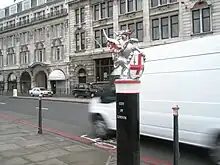Byward Street
Byward Street is a road in the City of London, the historic and financial centre of London. It forms part of the A3211 route and, if travelling eastward, is a short continuation of Lower Thames Street from a junction with Great Tower Street, to Tower Hill. It is located within the City ward of Tower.[1]


History
Constructed between 1895 and 1906 through the Met. and Dist. Railways (City Lines and Extensions) Act, 1882,[2] Byward Street replaced the much older Black Swan Court, itself the successor to a Roman foundation.[3] The street originally provided access to the Crown Gate of the Byward Tower, from which it derives its name.[4] The tower itself was so named because it was by the Ward (Warders' Hall; meeting room and residences of the Yeoman Warders).[5] Its close proximity to the Tower of London[6] and All Hallows-by-the-Tower church[7] ensure a steady stream of visitors,[8] for whom the nearby Underground station at Tower Hill. A number of retail outlets and restaurants also line Byward Street.
It formed part of the marathon course of the 2012 Olympic and Paralympic Games. The women's Olympic marathon took place on 5 August and the men's on 12 August. The Paralympic marathons were held on 9 September.[9][10]
References
- Harben, H. A. (1922). A Dictionary of London. London: Herbert Jenkins.
- "The City of London-a history" Borer,M.I.C. : New York,D.McKay Co, 1978 ISBN 0-09-461880-1
- "ViewFinder - Image Details". viewfinder.english-heritage.org.uk. Archived from the original on 6 June 2011. Retrieved 16 February 2008.
- "The Byward Tower, Tower of London". www.englishmonarchs.co.uk. Retrieved 19 December 2018.
- "The Warders' Hall, near the By-ward Tower (1840)". www.victorianweb.org. 13 September 2017. Retrieved 19 December 2018.
From: Ainsworth, William Harrison. The Tower of London. Illustrated by George Cruikshank. London: Richard Bentley, 1840.
- Which has not been part of the City, since the creation of Tower Hamlets in the 19th century
- "parish details". Archived from the original on 13 March 2008. Retrieved 16 February 2008.
- "Tourist hot spot".
- "London 2012 marathon men - Olympic Athletics". 3 June 2017. Archived from the original on 30 April 2013. Retrieved 28 July 2012.
- "London 2012 marathon women - Olympic Athletics". 3 June 2017. Archived from the original on 2 May 2013. Retrieved 28 July 2012.